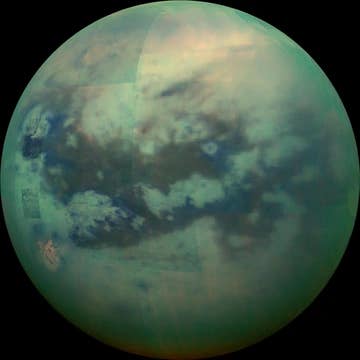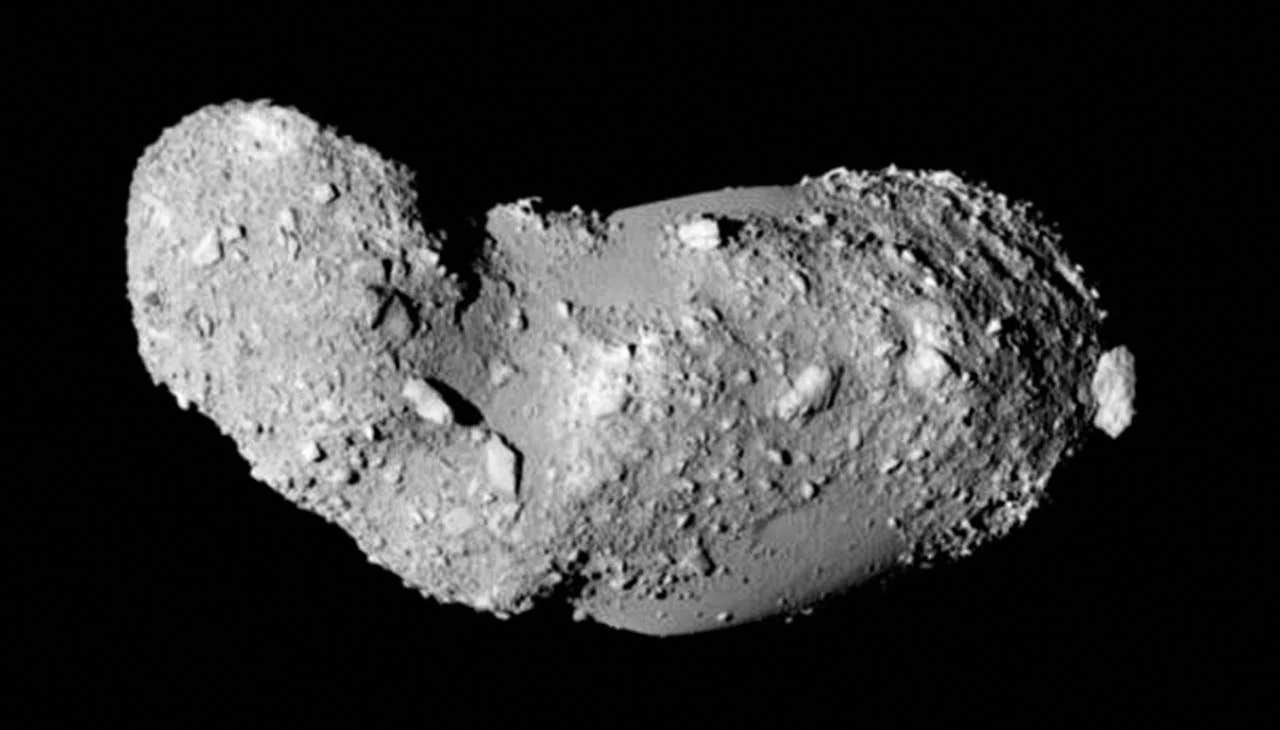Saturn’s moon Titan may support trace amounts of life, study finds
Saturn’s largest moon might not be the barren world it seems. Beneath Titan’s icy crust lies a vast ocean of liquid water—possibly as deep as 300 miles.

Composite image shows an infrared view of Titan from NASA’s Cassini spacecraft. (CREDIT: NASA/JPL/University of Arizona/University of Idaho)
Saturn’s largest moon might not be the barren world it seems. Beneath Titan’s icy crust lies a vast ocean of liquid water—possibly as deep as 300 miles. While its surface hosts lakes of methane and dunes made from organic-rich sands, it’s this hidden ocean that could quietly support life. But not as you'd expect.
Recent research published in The Planetary Science Journal explored whether Titan’s subsurface water ocean might support life—specifically, simple microbes that rely on fermentation. Led by Antonin Affholder of the University of Arizona and Peter Higgins of Harvard University, the team modeled how much life could possibly exist in this alien sea.
Organic Molecules Fall from the Sky
Titan’s atmosphere is thick and dense, unlike any other icy moon in our solar system. Photochemical reactions high above create complex organic molecules. These include polyaromatic hydrocarbons and amino acids like glycine, the simplest of its kind. Over time, these molecules settle onto the surface, covering the moon in dunes, plains, and labyrinth-like terrains.
Some of these organics get trapped in liquid hydrocarbon lakes made of methane, ethane, and nitrogen. According to planetary scientist M. Malaska, the total volume of organic material—both solid and liquid—ranges between 380,000 to 990,000 cubic kilometers.
Beneath this landscape, a thick icy crust, up to 200 kilometers deep, rests above the water ocean. Below that, a rocky core may still be geologically active. Past studies, including those cited by C. Sotin and colleagues, suggest that exchanges between these layers may have occurred throughout Titan's history, bringing energy and nutrients up from the core or down from the surface.
Life in the Depths: Not as Simple as It Sounds
The key question for astrobiologists is whether Titan’s ocean has the right conditions for life. It must offer essential elements like carbon, hydrogen, nitrogen, oxygen, phosphorus, and sulfur—collectively known as CHNOPS—as well as useful metals and ions. It must also offer enough energy to fuel metabolism, usually by providing both electron donors and acceptors.
Related Stories
On Earth, microbes gain energy through redox reactions involving oxygen or compounds like nitrate or sulfate. But Titan lacks strong oxidants like these. That's why the team considered a different, simpler process—fermentation.
“Fermentation probably evolved early in the history of Earth's life,” said Affholder. “It does not require us to open any door into unknown or speculative mechanisms that may or may not have happened on Titan.”
This process, familiar from sourdough and beer brewing, doesn’t need oxygen. It turns organic molecules directly into energy and fermentation products like hydrogen or acetate. On Titan, with its rich organic chemistry, fermentation seemed like a good bet.
Glycine: A Universal Ingredient
Affholder and his colleagues focused their study on glycine, a basic amino acid found across the solar system. “We know that glycine was relatively abundant in any sort of primordial matter in the solar system,” he said. That includes comets, meteorites, and interstellar clouds.
If glycine could make it from Titan’s surface into its ocean, it might support tiny fermenting life forms. The team previously found that impacts from meteorites could melt surface ice, creating pools of liquid water. These pools would then sink through the ice, possibly delivering glycine into the subsurface ocean.
Yet, their computer models showed that this supply route is slow. Optimistically, glycine might be delivered at a rate of less than 10 nanomoles per kilogram of ocean water per year. Most of Titan’s current ocean would have to rely on a "primordial" glycine stock—molecules delivered billions of years ago from the core.
A Sparse and Subtle Biosphere
Even with all the right ingredients and energy from fermentation, Titan’s biosphere would be tiny. The researchers estimated that its entire ocean might support only between 100 trillion to 100 quadrillion microbial cells in total. That’s just a few kilograms of carbon—less than the weight of a small dog.
Spread across Titan’s enormous ocean, that works out to fewer than one cell per kilogram of water. “Such a tiny biosphere would average less than one cell per liter of water,” said Affholder. Finding life under these conditions would be extremely difficult.
That’s why the team urges future missions to look for smaller, localized habitats. Areas where organic molecules might be more concentrated—like near impact sites or along cracks in the icy shell—might have higher chances of supporting life.
The study also points out that Titan's rich organics don't automatically make it a fertile place. “There has been this sense that because Titan has such abundant organics, there is no shortage of food sources that could sustain life,” said Affholder. “We point out that not all of these organic molecules may constitute food sources... so we argue for a more nuanced approach.”
The Bigger Picture of Ocean Worlds
Titan isn’t the only ocean world scientists are watching. Enceladus, another of Saturn’s moons, is much smaller but easier to study. During the Cassini mission, plumes of water vapor were seen spraying from Enceladus' surface, offering direct samples of its ocean.
Studies on Enceladus have considered whether methanogenesis—an energy-producing reaction using hydrogen and carbon dioxide—could sustain life. Researchers like A. Affholder, P. M. Higgins, and C. Ray have modeled these reactions and calculated how much microbial life they might support.
Now, those same methods are being used to study Titan. Unlike Enceladus, Titan’s thick atmosphere and complex surface make exploration harder. But its uniqueness also makes it one of the most interesting targets in the solar system.
“We asked, could similar microbes exist on Titan?” said Affholder. “If so, what potential does Titan’s subsurface ocean have for a biosphere feeding off of the seemingly vast inventory of abiotic organic molecules synthesized in Titan’s atmosphere?”
Answering that will take more data, better models, and eventually, another mission.
NASA’s Dragonfly Mission: A Step Toward Answers
In the coming years, NASA’s Dragonfly mission will send a drone-like rotorcraft to Titan. It will land near Titan’s equator and explore various sites, collecting data on surface chemistry and environmental conditions.
This mission could help settle whether organic molecules on the surface can indeed travel into the ocean. It may also detect hints of fermentation-like processes in the icy crust. But even with advanced instruments, locating life will be difficult.
“Our new study shows that this supply may only be sufficient to sustain a very small population of microbes,” said Affholder. That means even if life is present, it may be incredibly hard to detect—like a single drop of dye in an Olympic swimming pool.
Still, the mere possibility of life on Titan reshapes how scientists think about habitability. “We conclude that Titan’s uniquely rich organic inventory may not in fact be available to play the role in the moon’s habitability to the extent one might intuitively think,” Affholder said.
The team’s work, supported by the International Space Science Institute in Switzerland, calls for more targeted exploration and new strategies to identify subtle forms of life. Titan may not be teeming with microbes, but it still holds the keys to understanding how life might arise—and survive—in the most unexpected places.
Note: The article above provided above by The Brighter Side of News.
Like these kind of feel good stories? Get The Brighter Side of News' newsletter.
Joshua Shavit
Science & Technology Writer | AI and Robotics Reporter
Joshua Shavit is a Los Angeles-based science and technology writer with a passion for exploring the breakthroughs shaping the future. As a contributor to The Brighter Side of News, he focuses on positive and transformative advancements in AI, technology, physics, engineering, robotics and space science. Joshua is currently working towards a Bachelor of Science in Business Administration at the University of California, Berkeley. He combines his academic background with a talent for storytelling, making complex scientific discoveries engaging and accessible. His work highlights the innovators behind the ideas, bringing readers closer to the people driving progress.



